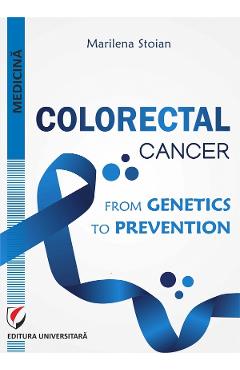- Informatii telefonice:(+40) 748 400 200
Colorectal cancer. From genetics to prevention - Marilena Stoian
Cod intern: xsales_1668503Producator: Marilena Stoian
Vizualizari: 29 / Achizitii: 25
Stoc: In stoc
Pret: 74.01 RON
Acest produs este publicat in categoria Librarie la data de 15-03-2025: 11:03 si vandut de Libris. Vanzatorul isi asuma corectitudinea datelor publicate. ( alege finantarea potrivita )
-
Produs cu garantie
-
Livrare direct din stocul fizic al Libris
-
Retur gratuit minim 14 zile de la data achizitiei
Most human CRCs are thought to arise from adenomas (adenomatous polyps) that become dysplastic. Adenomatous polyps form in the colon when normal mechanisms regulating epithelial renewal are disrupted. Surface cells lining the intestine are continuously lost into the bowel lumen due to apoptosis and exfoliation and must be continuously replaced. Typically, proliferation occurs exclusively at the crypt base. As cells move towards the luminal surface, they cease proliferating and terminally differentiate. This ordered process is increasingly disrupted as adenomas increase in size, become dysplastic, and eventually attain invasive potential. Th hypothesis that invasive CRCs develop from intermediate precancerous precursors is supported by pathologic, epidemiologic, and observational clinical data. The adenoma carcinoma sequence postulates that colorectal carcinomas arise from precursor lesions, called adenomas. All adenomas contain dysplastic epithelium that arises from mutations in either the adenomatous polyposis coli gene or DNA mismatch repair genes. The earliest lesion detected with dysplasia is the aberrant crypt focus. Over time, as this lesion acquires additional mutations, it evolves into a classic adenomatous polyp. Adenomatous polyps are classified as tubular, tubulovillous, or villous. Generally, as polyps increase in size, the degree of dysplasia worsens, the villous component increases, the number of genetic abnormalities increases, and the likelihood of harboring invasive carcinoma increases. Carcinomas associated with DNA mismatch repair mutations are more likely to be poorly differentiated and incite a host lymphocytic response. These tumors seem to have a better prognosis, stage for stage, than typical colorectal carcinomas. Evidence suggests that subtypes of serrated polyps, particularly TSA and SSA/P, can lead to adenocarcinoma through the serrated pathway. Moreover, the data indicate that the SSA/P are the precursors of colorectal carcinoma by MSI and may be subject to rapid progression to malignancy. An important step to reduce the incidence of CRC initiated by the serrated pathway is to improve the detection of serrated polyps and to ensure their complete removal during endoscopy. Understanding of the so called serrated carcinogenesis pathway is an important step forward in expanding possibilities in the prevention of CRC.



























Scrie parerea ta
Colorectal cancer. From genetics to prevention - Marilena Stoian
Ai cumparat produsul Colorectal cancer. From genetics to prevention - Marilena Stoian ?
Lasa o nota si parerea ta completand formularul alaturat.
Most human CRCs are thought to arise from adenomas (adenomatous polyps) that become dysplastic. Adenomatous polyps form in the colon when normal mechanisms regulating epithelial renewal are disrupted. Surface cells lining the intestine are continuously lost into the bowel lumen due to apoptosis and exfoliation and must be continuously replaced. Typically, proliferation occurs exclusively at the crypt base. As cells move towards the luminal surface, they cease proliferating and terminally differentiate. This ordered process is increasingly disrupted as adenomas increase in size, become dysplastic, and eventually attain invasive potential. Th hypothesis that invasive CRCs develop from intermediate precancerous precursors is supported by pathologic, epidemiologic, and observational clinical data. The adenoma carcinoma sequence postulates that colorectal carcinomas arise from precursor lesions, called adenomas. All adenomas contain dysplastic epithelium that arises from mutations in either the adenomatous polyposis coli gene or DNA mismatch repair genes. The earliest lesion detected with dysplasia is the aberrant crypt focus. Over time, as this lesion acquires additional mutations, it evolves into a classic adenomatous polyp. Adenomatous polyps are classified as tubular, tubulovillous, or villous. Generally, as polyps increase in size, the degree of dysplasia worsens, the villous component increases, the number of genetic abnormalities increases, and the likelihood of harboring invasive carcinoma increases. Carcinomas associated with DNA mismatch repair mutations are more likely to be poorly differentiated and incite a host lymphocytic response. These tumors seem to have a better prognosis, stage for stage, than typical colorectal carcinomas. Evidence suggests that subtypes of serrated polyps, particularly TSA and SSA/P, can lead to adenocarcinoma through the serrated pathway. Moreover, the data indicate that the SSA/P are the precursors of colorectal carcinoma by MSI and may be subject to rapid progression to malignancy. An important step to reduce the incidence of CRC initiated by the serrated pathway is to improve the detection of serrated polyps and to ensure their complete removal during endoscopy. Understanding of the so called serrated carcinogenesis pathway is an important step forward in expanding possibilities in the prevention of CRC.
Acorda un calificativ